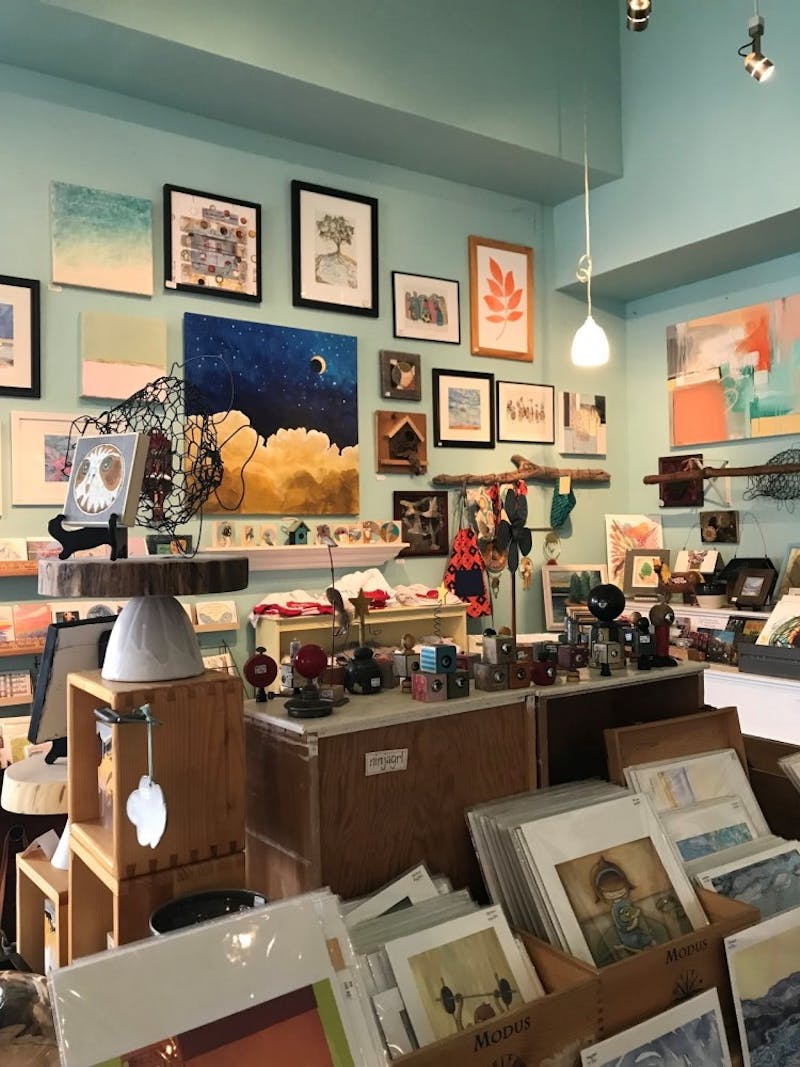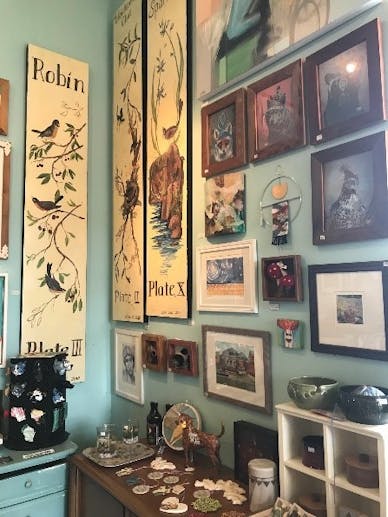
Hatch Art House is located on Williamson St. in the east side of Madison. The shop has become a leading local example for sustainability in art.
Image By: Sam Jones
Hatch Art House is located on Williamson St. in the east side of Madison. The shop has become a leading local example for sustainability in art.
Image By: Sam JonesAs I walked into Hatch, I was taken aback by the magnitude of work in its space: canvases stretched across the walls, ceramic incense holders and mugs were spread across the tables and larger pieces of work lined the floors. It wasn’t overwhelming, however; it was rather comforting.
Tammy Schreiter, the owner of Hatch Art House, has always instilled values of affordability, eco-friendly procedures and creativity in her business.
“I strive for Hatch to be a vibrant space, full of fun, beautiful and unique hand-crafted items and fine art.”
An artist herself with an MFA in painting and an emphasis on multimedia work, Tammy knows what it is like to be a creator in the oftentimes elitist world of art, with expensive materials, politicized gallery selection processes and a lack of profit for artists early in their career.
So, she decided to combat that in the most direct way she knew how:
“I opened Hatch to have a space where emerging artists would feel comfortable showing their work, as well as customers that wanted to buy art, but perhaps couldn't afford typical, art-gallery art,” Schreiter said. “We have a very casual, inviting environment here.”
Hatch Art House, which opened its doors on the iconic Willy Street in 2010, exclusively displays work from Wisconsin artists. Its showroom exhibits extensive and varying works from upcycled bundt cake tin dolls to anti-war multimedia paintings incorporating Scrabble pieces.
This hodgepodge of mediums and messages may be in part due to Hatch’s emphasis on sustainability and reuse of everyday objects in art. Schreiter said she has seen artists use various eclectic objects in their work, such as discarded computer parts and bird feathers.
“The sky is the limit,” she said.
Upcycled and sustainable art more broadly isn’t new by any means, having made a splash in mainstream art at the beginning of the 20th century.

Sustainable art advocates for the split from materialization and wasteful consumer culture and thus found a stable home in the environmentalism movement of the 1960s and 70s.
On the other hand, upcycled art — art that highlights waste and/or already-used objects — was coined as a form of art and lifestyle in 2002 by William McDonough and Michael Braungart and has altered the creative landscape since due to its ingenuity, affordability and social commentary.
As our global climate situation becomes direr and the environmentalism movement becomes more and more mainstream, we can expect that these trends won’t die out any time soon.
Much of Hatch’s work is eco-friendly from the reuse of frames to only accepting local art, which minimizes transportation costs and reduces a piece’s emission trail.
Yet, Schreiter wanted to do more.
“I thought it would be fun to have a specific art show, where we would invite artists to enter, and they would have to include something that was upcycled,” she said.
Schreiter has hosted the EcoSquared art show at Hatch seven times.
“Every piece has to be square, between 4-12 inches squared, and they have to include at least one item that is upcycled,” she said.
These open-ended submission requirements result in a fun, diverse mix of work, according to Schreiter, which typically comes from around 15 to 30 artists. She emphasized these shows help display the beauty of upcycled items, which differs from the use of recycled items.
For example, recycling a bottle may entail crushing it up and turning it back into a glass bowl or another type of item, whereas upcycling that bottle could mean painting it as a vase or using its shards as the highlight of a ceramic piece.
Thus, the difference between them is that recycling is hiding its prior form and use, meanwhile upcycling emphasizes the beauty of an item’s versatility and past, bringing attention to consumer culture and the massive amounts of waste we produce.
Ultimately, Hatch is more than just a one-stop-shop for your artistic needs. Sustainability is actively incorporated into the core of their mission, and they actively make social commentary on materialism and elitism in art.
Sam Jones is an almanac editor for the Daily Cardinal. To read more of her work, click here.